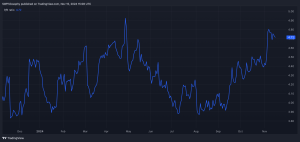NatWest (LSE: NWG) shares have had a stunning run. After going nowhere fast for years they’ve now shot up 44.31% in 12 months. That’s almost five times faster than the FTSE 100 as a whole (up 9.13% over the same period).
The catalyst was its forecast-topping full-year results for 2023, published on 16 February, which showed pre-tax profit jumping almost 22% to £6.2bn.
Top FTSE 100 recovery stock
Impairment charges were lower than expected, as consumers withstood higher inflation and interest rates. Newly appointed CEO Paul Thwaite said he expected this to continue, unless unemployment rocketed. It hasn’t so far.
Crucially, net interest margins, a key measure of banking profitability, rose 19 basis points to 3.04%. NatWest hiked the full-year dividend by a huge 26% in 2023, to 17p per share. Investors went bananas.
NatWest fired the starting pistol for what’s been a successful year for banking stocks. Lloyds Banking Group shares (which I hold) are up 35.97% over 12 months, while the Barclays share price is up 48.53%.
NatWest’s first-half 2024 results, published on 26 July, were also warmly received. Investors overlooked a decline in interim profits, triggered by falling net interest margins and rising costs, and celebrated an increase in full-year income guidance. Q2 loan impairments of £45m came in way below estimates of £161m. NatWest hiked the interim dividend by 9% to 6p.
NatWest’s the last bank to still be part-owned by taxpayers, but that isn’t expected to last much longer. Chancellor Rachel Reeves seems likely to axe the planned ‘Tell Sid’ retail sale and offer the government’s £5.6bn stake to pension funds, insurers and asset managers instead.
We’ll know for sure in the Autumn Statement, but I can’t imagine Reeves doing anything else. I see little point in holding back in the hope of bagging NatWest at a discounted offer price.
Low valuation, high yield
The NatWest share price recovery was driven by a more optimistic outlook, as the cost-of-living crisis appeared to ease. Yet we are now in a new world of fear, as investors fret about a Chinese slowdown and potential US recession. NatWest fell 3.56% last week.
One or two more interest rate cuts are likely this year, which are likely to squeeze margins but may also reduce impairments further. Tax hikes in the Autumn Statement may hit sentiment, especially if Reeves slaps a windfall tax on banks. They’re an easy target as she looks to close the £22bn black hole she’s identified.
This partly explains why NatWest shares have run out of steam lately and remain cheap, trading at just 6.7 times earnings. The price-to-book value’s also tempting at just 0.72 (a figure of 1 is seen as fair value).
With a forecast yield of 5.21% and recent inflation-busting dividend hikes, NatWest looks a solid buy for income seekers. There’s so much to like here, but I’m worried about that windfall tax. I already have exposure to that threat via my stake in Lloyds. On balance, I think I’ll wait.
This post was originally published on Motley Fool







